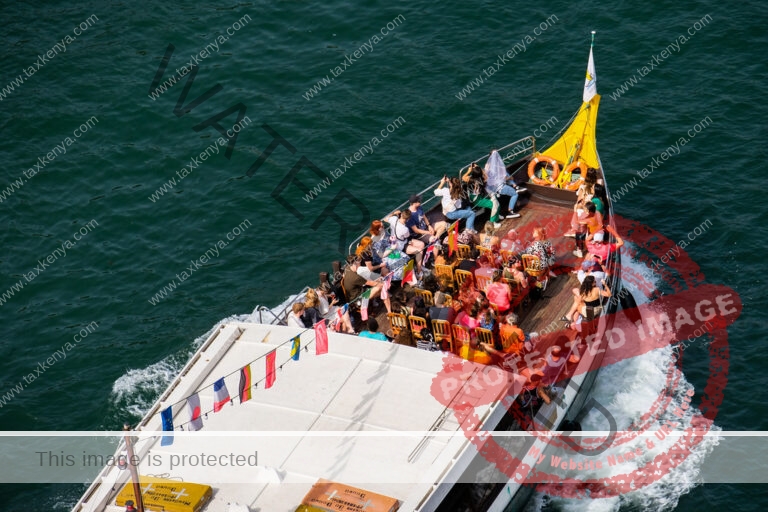Weeks before the President departed for China, the media had told Kenyans that the President was going to discuss the acquisition of a kshs 368billion loan from the Chinese to extend the SGR beyond Naivasha to Kisumu.
Introduction
There are conflicting reports about what the Kenyan President went to do in China.
Weeks before the President departed for China, the media had told Kenyans that the President was going to discuss the acquisition of a kshs 368billion loan from the Chinese to extend the SGR beyond Naivasha to Kisumu.
The President was also attending the second Chinese Belt and Road initiative summit.
The President was also attending the second Chinese Belt and Road initiative summit.
The President’s trip created excitement all over the country for various reasons especially consumer reasons. Kenyans are known to transform into one hundred per cent consumers when they get free monetary windfalls. Ask the land sellers of the SGR section from Mombasa to Nairobi.
Today, they many are cursing the SGR money for the misery the money has caused them.
With the Chinese loan for the section from Naivasha to Kisumu, money from the land sale was coming and with it many opportunities. At the family front, the polygamous sections in the Kenyan Constitution were to be utilized to the maximum: second wives, third wives, fourth wives, “mpango ya kando” etc.
This was to spell the end of singlehood for many Kenyans.
Also, second-hand vehicle yards were to be emptied, everybody with the SGR money would have wanted to buy a vehicle. Further, demand for alcohol was likely to make the beer manufacturers operate twenty-four seven.
Of course, a few people would have engaged in constructive activities such as educating their children, starting businesses, developing the part of the land not taken by SGR etc.
After the President came back, the media changed the story… now the media is talking about the President managing to sign avocado market deals. The way the media is talking about the avocado market deals is like it is the worst thing that the President could have got for Kenya. After all, avocados are given out for free in most homesteads, so what are the big deals with the President signing an avocado market deal?
What the media is not telling us is that the avocado market deal is by far better than a loan. We can sell the avocados and get money to build the SGR, pay off the debts and be loan free.
If the Chinese have refused their money, we have leant lessons. After all, it is their money and it is not for free. If the Chinese want to buy our avocados, there are lessons to learn. The Chinese must ensure that we are working hard to repay our loans.
Chinese loans
The Chinese have refused to give us a loan. Maybe the Chinese are not sure that we will be in position to pay the loans and instead of pushing us further into the debt hole, they have decided to show us how to get out of the loan trap by engaging in some economic activities e.g. avocado farming and they will buy the avocados from us.
Sometimes back, in one of the many articles, someone said that the African, Kenyans included has been behaving like an alcoholic as far as the Chinese money is concerned. The African has an elephant sized appetite for the Chinese money. The writer forgot to explain further and inform us that though any owner of alcohol is eager to sell, payment is prime.
No business transaction is complete unless payment is collected. And every good sales person will tell you that every sale must be evaluated against the possibility of non-payment. Any possibility of nonpayment is disastrous for the buyer and the seller.
We have Chinese loans.
A loan is a “thing that is borrowed” such as a pen, food, “jembe”, money etc. When the thing is money, there is a cost called interest and this can range from zero (0%) percent to whatever amount depending on the agreement in place. This is because of time value of money. The loanee must assure the owner of the money that it will be paid back. The money owner must be convinced beyond any doubt.
Many times money owners monitor what the loanees are doing with the money and the next time the loanee requires any extra money, more stringent conditions are imposed.
Kenya, like many African states is a loanee of Chinese government money. The Chinese have been accused of being over generous with their money with the aim of entrapping African countries to debt – hence the loan prognostication equivalent to alcoholism. Maybe this is not true after all.
If it is true that the Chinese have refused to give us a loan to extend the SGR to Kisumu, there are only two things to read from their actions: they are not sure of our capacity to repay the loans based on what we are doing with the money or it is a continuation of their “alcoholism” entrapment maneuvers.
Imagine the desperation of an alcoholic who is refused a bottle of beer until they provide evidence that they can pay for what they have already been loaned.
Chinese money is not free money, besides there are no “free lunches”. The money comes with interest costs which unfortunately are foreign currency based. This is disastrous for our country in case of any possibility of devaluing the good old Kenya shilling.
To get more SGR loans, Kenya must provide evidence that the SGR investment is viable. That is there is enough business for the SGR to be operated profitably with adequate profits to repay the loans. Already, the completed section of SGR from Mombasa to Nairobi which is the busiest is not economically viable.
If media reports are anything to go by, Kenya has to pay kshs 1billion every month for SGR’s operations. Simply put, SGR expenses are more than the income generated by SGR on a monthly basis.
Comparatively, there is little business from Nairobi towards and from the Western part of the country apart from import and export cargo from and to Uganda, Rwanda and Eastern part of Democratic Republic of Congo (DRC). However, this may change with the extension of the SGR to Naivasha and the construction of the dry inland deport. Probably the investment on the SGR to Kisumu will then become a feasible development.
Though the country did not get the loan for the extension of the rail, all is not lost. How much of the loan money was going towards the actual rail construction? If we go by the figure used to pay off land owners in the Mombasa-Nairobi phase, approximately kshs 33billion which is 10% of the kshs 327billion construction cost was used for land compensation.
For the section between Naivasha and Kisumu, the land compensation figure was likely to be higher than the ten percent (10%) since this section has fertile agricultural land unlike most of the first phase section which was largely through the game parks which are owned by and occupy government land.
The second reason is that the current owners of the land on the SGR route from Naivasha to Kisumu which was to be procured for the extension are likely to be land brokers who bought land for speculative purposes. This means that a large percentage of the loan money was to be utilized to pay off the land brokers at inflated prices along the SGR route.
The third reason is the possibility of political incitement. In the SGR section between Nairobi and Naivasha, some land owners were incited against the project first because of land prices and payment for the land and second because of employment opportunities. This resulted in delays in the construction of the section and there were threats to the Chinese workers.
Delay in any project is expensive because of cost overruns. Besides, the Chinese must also have noted the threat to their citizens.
Therefore, though we are disappointed because of the lack of money to take the SGR to Kisumu, all is not lost.
Avocado marketing deal
The media has told us that the President managed to ink an avocado marketing deal. This is good enough. As of Friday, April 2019 based on the United Nation’s estimates, China’s population was 1,419,147,756 people equivalent to approximately 18.41 % of the World’s population. The President signed the trade pack for Kenyan farmers to supply avocados to be consumed by the majority of these people especially the middle and upper classes in the society.
Though Mexico is the largest exporter of avocados to USA exporting 454million kilos of avocados, the country is also exporting a lot of avocados to China. Other Central American countries are also currently exporting approximately 3.178 million kilos of avocados to China. Internet sources indicate that a dollar price per avocado would see the fruits flying from the shelves.
This shows that there is a huge current and future potential for Kenyan avocados in China.
Currently, Kenya exports avocados worth more than kshs 1billion per year. The opening of the Chinese market will increase this volume if the farmers are willing to work harder with government support. Kenya’s target should be to have every Chinese consume at least ten avocados from the country in a year. This will make Kenya a strong trading Chinese partner and ease Chinese debt repayment.
In the process, jobs will be created in several economic sectors including commerce (marketing jobs), the agricultural sector (farms, agricultural inputs), manufacturing sector (packaging materials), transport, etc. There will also be economic development especially in the infrastructure sector and the rural areas. We are also likely to see reverse migration from urban to rural areas.
The avocado market deal has the potential to repay the current Chinese loans and all other loans. Currently, the Chinese debt repayment is standing at kshs 18.27 billion for the financial year 2019/2020. With the avocado market deal, Kenya only requires to export to China 182,700,000 avocados every year. The government can figure out how to go about it with a population of 40million persons.
Each Kenyan would be required to produce 4.56 avocados per year.
Alternatively, assuming that the total Kenya debt to China is kshs 800 billion, each of the 40 million Kenyans can sacrifice and should provide 200 avocados to be delivered to China at 1 US dollar each and our loans will be fully repaid. This is doable but the question is how long will it take. The Kenyan people must work to repay the Chinese loans until they are fully repaid.
The Kenya government should seek more market deals for Kenyan produce.
On tax, loans and avocado market
If it is true that Kenya was denied loans for the SGR section from Naivasha to Kisumu, the taxpayers stand to benefit in the short-term because they are not going to be overburdened yet again with an extra international debt to pay. Current national debt repayments are already a problem…there is no money to do all that the government is required to do.
The avocado market deal is a great deal that will benefit the taxpayers in many ways. There are many sectors in the economy that will be affected positively by the new-found market for the avocados. For example, more people can now engage in avocado farming and generate income. There will be increased business in the other sectors of the economy that will most likely result in increased taxable income.
The government can tax the income and generate tax revenues to develop the country and pay off some of the Chinese loans.
Rehabilitation of the Metre Gauge Railway
There is talk in town that the government intends to rehabilitate the old rail line referred to as Metre Gauge Railway now that there is no money to construct the SGR. There is an African proverb that “a string outside the house takes care as the rope is awaited”.
Simply put, “you do with what you have as you make plans for better things”.
The Metre Gauge Railway served the East African community for many years. This railway line was at the heart of effective and efficient British colonisation of East Africa. Most of the hinterland developments witnessed today is as a result of the railway line. Apart from our very unique nature of preferring new things, there was absolutely nothing wrong with the Metre Gauge Railway.
Old yes, it was, but most of the railway lines currently being used in Britain and Europe are older than this line.
By the way, did we complete payment of the loan that was used to build this railway?
There are many advantages to rehabilitating this railway. The railway line is still there and the land too is in place though it may have encroached. We have all the engineers and drivers still around. And at the cost of kshs 40billion, it is even cheaper. With the current economic hardships being experienced in the country, it makes economic sense to rehabilitate the railway line. If the government does not have the money, it can float an infrastructure bond specifically to rehabilitate the railway line. I can bet it will be over-subscribed.
Future of Naivasha-Kisumu SGR
There is the prestige of the SGR. However, between a railway line and a road which is more economical in terms of cost and economic impact? Doing a dual carriageway from Naivasha to Kisumu and the SGR which one would have a more positive impact in terms of economic growth? Before the construction of Eastern By-pass in Nairobi, the surrounding areas were grasslands. But today, the economic development is astronomical courtesy of the Eastern Bypass.
A closer assessment of the SGR from Mombasa to Nairobi and a dual carriageway covering the same distance which one would have had more impact? A carriageway any day would have been better. The reason is that all towns along the way would have developed and others would have come up. The economic impact would have been experienced far and wide. All business including the oldest professions would have grown.
The denial of the loan for the SGR phase 3 may be a blessing in disguise.
Conclusion
No matter what the President went for from China, the fact is that he did not come back empty-handed. The Chinese have shown that their money is not for free and it never was. Kenyans, like other Africans, will start to work hard to repay Chinese loans. The avocado market deal is better any day than the SGR loan deal because of the wider economic implications. An opportunity has been created for the hard-working Kenyan farmers to benefit at the expense of the lazy land brokers.
However, all is not lost for the land brokers because they can farm avocados on the land they had acquired for speculative purposes to sell for SGR. Only that this time, the land brokers will have to work hard and it will take time for them to get money. This is a classic case of getting a fishing rod instead of a fish.
The avocado market deal is better any day. Kenyans need more of these market deals.
Feel free to send us tax and investments in Kenya questions or topics via email taxkenya@gmail.com that you would wish to be covered in this Website.
Disclaimer
This post is for general overview and guidance and does not in any way amount to professional advice. Hence, www.taxkenya.com, its owner or associates do not take any responsibility for results of any action taken on the basis of the information in this post or for any errors or omissions. Kenyan taxpayers must always rely on the most current information from KRA. Tax industry in Kenya is very dynamic.




